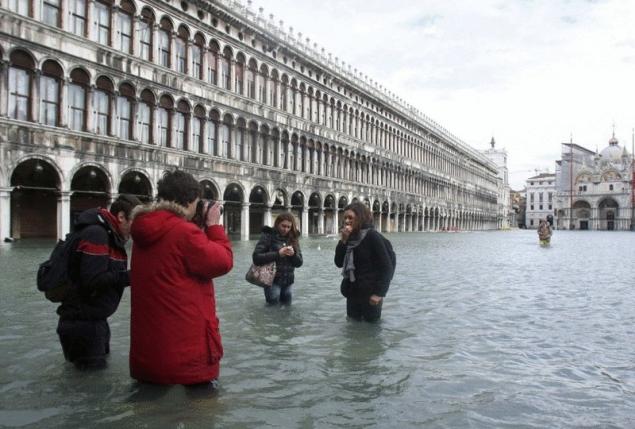577
Cities that may disappear underwater
Venice
Sea level is sufficient to rise by just 1 meter to disappear from the face of the Land of the legendary Venice. Tourist hot spot is a must visit if You are interested in religion, art, architecture, or just have a taste for the finer things in life. In this case, this coastal Italian city is the place for You. However, the city, with its intricate network of canals and waterways at risk as a result of increasing water level and its effects on local soil. In 2008 the town was struck by devastating floods that caused severe damage. This cataclysm was repeated in January of this year, as heavy rainfall coincided with high tides. The cost of repairing the buildings already damaged by these floods is estimated in the tens of millions of dollars. Only a meter of sea-level rise will be enough to submerge the city under water.

Amsterdam
The level of the oceans enough to rise only 2 meters to sink Amsterdam. The Netherlands is located in the lowlands, where one quarter of the country is actually below sea level! Large dams protect the land from flooding and allow the Dutch to explore the territory, which have long to be swallowed by the sea. The problem is that when the seas levels rise, these dikes are experiencing more pressure. With the tides and the storms they are at risk of destruction. Like Venice, Amsterdam is connected by a series of internal waterways, because the sea level could easily threaten the low-lying city. According to preliminary estimates, Amsterdam has about 150 years before he will become the new Atlantis.
Hamburg
In the case of Hamburg, the water will rise to 2.5 meters. The city, which is the second largest in Germany located on the floodplain of the river Elbe, just over 100 kilometers from the North sea coast. The city is regularly affected by floods due to heavy rains and flows and with the increase in global sea level this process will only intensify. The city really is a modern defence system against floods, but as in the case of the Netherlands, it may be ineffective when the water level rises. In recent years, however, neither the mighty Elbe river or the ocean have not caused problems such as small rivers and streams within the boundaries of Hamburg. In 2002, they had incurred approximately $20.8 million in damage to the city.
Saint Petersburg
Saint Petersburg may also threaten the water rise by 2.5 meters. Russia's Northern capital Saint Petersburg is a picturesque city, often called the “Venice of the North”. Located at the mouth of the mighty Neva river, the city itself is based on a series of Islands connected by numerous bridges. The comparison with Venice is, however, also alludes to the relationship of St. Petersburg with water surrounding it. The population of the city are used to regular floods and sea level rise, but in recent years they have become more frequent and more dangerous. The flood barriers protecting the city from the Finnish Gulf, also operates a system of flood warning. These defense systems cost a huge amount of money for the Russian state, but without them the city will almost certainly captured by the water. St. Petersburg's defense system, which was completed in 2010, is now serving as a model for several other low-lying cities. About the famous bridges of St. Petersburg, see the separate article.
Los Angeles
Los Angeles will require lifting the water three feet. Los Angeles, like all of California is probably the area that we often associate with drought, not flooding. But this coastal town is also at risk of flooding. This is the first of two California cities on our list. The concentration of industry and high population is an important factor that would contribute to the devastating effects of flooding in Los Angeles. According to preliminary calculations, the city has at least 200 years before the sea begins to get closer to him. University of southern California conducted a multilevel study in the Pacific and predicts an increase from 5 to 25 inches on the West coast. This means that the coastline of the state will gradually eat up the sea, destroying buildings and whole cities in the coastal zone.
San Francisco
Since San Francisco is close to Los Angeles, raising the level of the sea there is also 3 meters. The second Californian city on our list, San Francisco is known worldwide for its majestic Golden Gate, the impressive architecture and beautiful nature. The city was founded on the Peninsula, curving near the mainland. This land, however, is at risk from increasing sea levels and despite the mountainous terrain around California, Peninsula, San Francisco will be extremely difficult to defend. It should be noted that these two California cities mentioned in this list because of their large size. In fact, flooding is threatening and all the other coastal areas on the West coast – all of these areas are equally at risk. The increasing level of the world ocean can absorb all coastal land, and the protection level here for the moment, is not high. Perhaps this is due to the fact that there are no such floods, which threaten St. Petersburg, Venice, and other cities from the list.
New York, Lower Manhattan
As in San Francisco, a significant part of the population and the strategic importance of the Manhattan and really make it a risky area. The recent destruction of Hurricane sandy and the storms before him have already demonstrated that new York is now seriously in need of a new defense system against floods. Tragic tropical cyclone of 2012 killed 117 people in the United States and 69 more in Canada and the Caribbean. He has set new records for flooding in the new York region. The estimated cost of damage to new York was $41.9 billion. Since then, questions have been raised about how Manhattan and the entire Eastern seaboard will meet with such storms in the future. The combination of high population density and low-lying lands on the island of Manhattan mean that the risks potentially fatal. According to estimates, if the ocean rises by 3 meters, this part of new York city will be completely flooded.
New Orleans
Undoubtedly, the New Orleans — American city, most tragic associated with losses and expenses from the flood. The devastation along the Mississippi Delta in recent years has highlighted how vulnerable are actually people faced with the threat of more aggressive storms and rising seas levels. Hurricane Katrina almost destroyed the most parts of the city. The lowest levees in New Orleans have approximately 350 years before the increasing levels of the seas will absorb them. Since hurricane Katrina, gradually recovering New Orleans has significantly increased protection from flooding. A chain of gates, dams and canals of the city now is the best defense system in the United States. Unfortunately, all this was done only after there was such a terrible tragedy.
South London
To destroy South London, required increase in global sea level of 5.5 metres. The myth of London, swallow the sea, excites the public for a long time. In fact, this myth has a considerable share of reality. Why? The city itself is built around the mouth of the Thames, and the landscape, which is a large part of the city, especially on the South and East is a swamp. This means that it absorbs too much water even in the best of times. Imagine what would happen if the area is flooded because of rising sea levels! In fact, London has approximately 375 years before it will go the way of Atlantis, and currently the city has extensive defense system -the Thames Barrier that protects from tides. New problem is the flood of the river Thames upstream that affects the entire suburb of London.
Shanghai
The Shanghai stock is as much as 6.5 meters, which may be a catastrophe. Much like Los Angeles and San Francisco, Shanghai — only one of several Chinese cities that are threatened by the increase of the sea level; among the other cities of Guangzhou, Hong Kong and Shenzhen. 6.5-foot raise could take approximately 400 years, and completely flooded the city. It should be noted that this worst-case scenario – but even a small increase in level in a shorter period of time still can greatly harm the city. For example, if the levels will rise by half a meter by 2070, then 5.5 million people in the city will be in danger. Here is a very poorly developed system of flood protection, and the authorities are just starting to think about it. Continuing the theme also read about other places on the brink of extinction.
Source: lifeglobe.net/
Sea level is sufficient to rise by just 1 meter to disappear from the face of the Land of the legendary Venice. Tourist hot spot is a must visit if You are interested in religion, art, architecture, or just have a taste for the finer things in life. In this case, this coastal Italian city is the place for You. However, the city, with its intricate network of canals and waterways at risk as a result of increasing water level and its effects on local soil. In 2008 the town was struck by devastating floods that caused severe damage. This cataclysm was repeated in January of this year, as heavy rainfall coincided with high tides. The cost of repairing the buildings already damaged by these floods is estimated in the tens of millions of dollars. Only a meter of sea-level rise will be enough to submerge the city under water.

Amsterdam
The level of the oceans enough to rise only 2 meters to sink Amsterdam. The Netherlands is located in the lowlands, where one quarter of the country is actually below sea level! Large dams protect the land from flooding and allow the Dutch to explore the territory, which have long to be swallowed by the sea. The problem is that when the seas levels rise, these dikes are experiencing more pressure. With the tides and the storms they are at risk of destruction. Like Venice, Amsterdam is connected by a series of internal waterways, because the sea level could easily threaten the low-lying city. According to preliminary estimates, Amsterdam has about 150 years before he will become the new Atlantis.
Hamburg
In the case of Hamburg, the water will rise to 2.5 meters. The city, which is the second largest in Germany located on the floodplain of the river Elbe, just over 100 kilometers from the North sea coast. The city is regularly affected by floods due to heavy rains and flows and with the increase in global sea level this process will only intensify. The city really is a modern defence system against floods, but as in the case of the Netherlands, it may be ineffective when the water level rises. In recent years, however, neither the mighty Elbe river or the ocean have not caused problems such as small rivers and streams within the boundaries of Hamburg. In 2002, they had incurred approximately $20.8 million in damage to the city.
Saint Petersburg
Saint Petersburg may also threaten the water rise by 2.5 meters. Russia's Northern capital Saint Petersburg is a picturesque city, often called the “Venice of the North”. Located at the mouth of the mighty Neva river, the city itself is based on a series of Islands connected by numerous bridges. The comparison with Venice is, however, also alludes to the relationship of St. Petersburg with water surrounding it. The population of the city are used to regular floods and sea level rise, but in recent years they have become more frequent and more dangerous. The flood barriers protecting the city from the Finnish Gulf, also operates a system of flood warning. These defense systems cost a huge amount of money for the Russian state, but without them the city will almost certainly captured by the water. St. Petersburg's defense system, which was completed in 2010, is now serving as a model for several other low-lying cities. About the famous bridges of St. Petersburg, see the separate article.
Los Angeles
Los Angeles will require lifting the water three feet. Los Angeles, like all of California is probably the area that we often associate with drought, not flooding. But this coastal town is also at risk of flooding. This is the first of two California cities on our list. The concentration of industry and high population is an important factor that would contribute to the devastating effects of flooding in Los Angeles. According to preliminary calculations, the city has at least 200 years before the sea begins to get closer to him. University of southern California conducted a multilevel study in the Pacific and predicts an increase from 5 to 25 inches on the West coast. This means that the coastline of the state will gradually eat up the sea, destroying buildings and whole cities in the coastal zone.
San Francisco
Since San Francisco is close to Los Angeles, raising the level of the sea there is also 3 meters. The second Californian city on our list, San Francisco is known worldwide for its majestic Golden Gate, the impressive architecture and beautiful nature. The city was founded on the Peninsula, curving near the mainland. This land, however, is at risk from increasing sea levels and despite the mountainous terrain around California, Peninsula, San Francisco will be extremely difficult to defend. It should be noted that these two California cities mentioned in this list because of their large size. In fact, flooding is threatening and all the other coastal areas on the West coast – all of these areas are equally at risk. The increasing level of the world ocean can absorb all coastal land, and the protection level here for the moment, is not high. Perhaps this is due to the fact that there are no such floods, which threaten St. Petersburg, Venice, and other cities from the list.
New York, Lower Manhattan
As in San Francisco, a significant part of the population and the strategic importance of the Manhattan and really make it a risky area. The recent destruction of Hurricane sandy and the storms before him have already demonstrated that new York is now seriously in need of a new defense system against floods. Tragic tropical cyclone of 2012 killed 117 people in the United States and 69 more in Canada and the Caribbean. He has set new records for flooding in the new York region. The estimated cost of damage to new York was $41.9 billion. Since then, questions have been raised about how Manhattan and the entire Eastern seaboard will meet with such storms in the future. The combination of high population density and low-lying lands on the island of Manhattan mean that the risks potentially fatal. According to estimates, if the ocean rises by 3 meters, this part of new York city will be completely flooded.
New Orleans
Undoubtedly, the New Orleans — American city, most tragic associated with losses and expenses from the flood. The devastation along the Mississippi Delta in recent years has highlighted how vulnerable are actually people faced with the threat of more aggressive storms and rising seas levels. Hurricane Katrina almost destroyed the most parts of the city. The lowest levees in New Orleans have approximately 350 years before the increasing levels of the seas will absorb them. Since hurricane Katrina, gradually recovering New Orleans has significantly increased protection from flooding. A chain of gates, dams and canals of the city now is the best defense system in the United States. Unfortunately, all this was done only after there was such a terrible tragedy.
South London
To destroy South London, required increase in global sea level of 5.5 metres. The myth of London, swallow the sea, excites the public for a long time. In fact, this myth has a considerable share of reality. Why? The city itself is built around the mouth of the Thames, and the landscape, which is a large part of the city, especially on the South and East is a swamp. This means that it absorbs too much water even in the best of times. Imagine what would happen if the area is flooded because of rising sea levels! In fact, London has approximately 375 years before it will go the way of Atlantis, and currently the city has extensive defense system -the Thames Barrier that protects from tides. New problem is the flood of the river Thames upstream that affects the entire suburb of London.
Shanghai
The Shanghai stock is as much as 6.5 meters, which may be a catastrophe. Much like Los Angeles and San Francisco, Shanghai — only one of several Chinese cities that are threatened by the increase of the sea level; among the other cities of Guangzhou, Hong Kong and Shenzhen. 6.5-foot raise could take approximately 400 years, and completely flooded the city. It should be noted that this worst-case scenario – but even a small increase in level in a shorter period of time still can greatly harm the city. For example, if the levels will rise by half a meter by 2070, then 5.5 million people in the city will be in danger. Here is a very poorly developed system of flood protection, and the authorities are just starting to think about it. Continuing the theme also read about other places on the brink of extinction.
Source: lifeglobe.net/
























